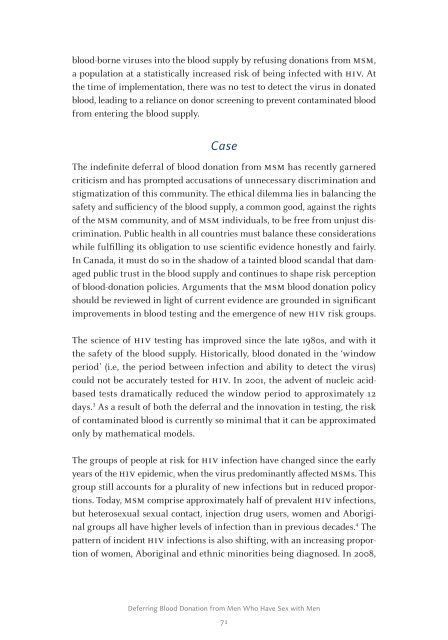PoPulationand Public HealtH etHics
PoPulationand Public HealtH etHics
PoPulationand Public HealtH etHics
You also want an ePaper? Increase the reach of your titles
YUMPU automatically turns print PDFs into web optimized ePapers that Google loves.
lood-borne viruses into the blood supply by refusing donations from MsM,<br />
a population at a statistically increased risk of being infected with HIV. At<br />
the time of implementation, there was no test to detect the virus in donated<br />
blood, leading to a reliance on donor screening to prevent contaminated blood<br />
from entering the blood supply.<br />
Case<br />
The indefinite deferral of blood donation from MsM has recently garnered<br />
criticism and has prompted accusations of unnecessary discrimination and<br />
stigmatization of this community. The ethical dilemma lies in balancing the<br />
safety and sufficiency of the blood supply, a common good, against the rights<br />
of the MsM community, and of MsM individuals, to be free from unjust discrimination.<br />
<strong>Public</strong> health in all countries must balance these considerations<br />
while fulfilling its obligation to use scientific evidence honestly and fairly.<br />
In Canada, it must do so in the shadow of a tainted blood scandal that damaged<br />
public trust in the blood supply and continues to shape risk perception<br />
of blood-donation policies. Arguments that the MsM blood donation policy<br />
should be reviewed in light of current evidence are grounded in significant<br />
improvements in blood testing and the emergence of new HIV risk groups.<br />
The science of HIV testing has improved since the late 1980s, and with it<br />
the safety of the blood supply. Historically, blood donated in the ‘window<br />
period’ (i.e, the period between infection and ability to detect the virus)<br />
could not be accurately tested for HIV. In 2001, the advent of nucleic acidbased<br />
tests dramatically reduced the window period to approximately 12<br />
days. 3 As a result of both the deferral and the innovation in testing, the risk<br />
of contaminated blood is currently so minimal that it can be approximated<br />
only by mathematical models.<br />
The groups of people at risk for HIV infection have changed since the early<br />
years of the HIV epidemic, when the virus predominantly affected MsMs. This<br />
group still accounts for a plurality of new infections but in reduced proportions.<br />
Today, MsM comprise approximately half of prevalent HIV infections,<br />
but heterosexual sexual contact, injection drug users, women and Aboriginal<br />
groups all have higher levels of infection than in previous decades. 4 The<br />
pattern of incident HIV infections is also shifting, with an increasing proportion<br />
of women, Aboriginal and ethnic minorities being diagnosed. In 2008,<br />
Deferring Blood Donation from Men Who Have Sex with Men<br />
71
















